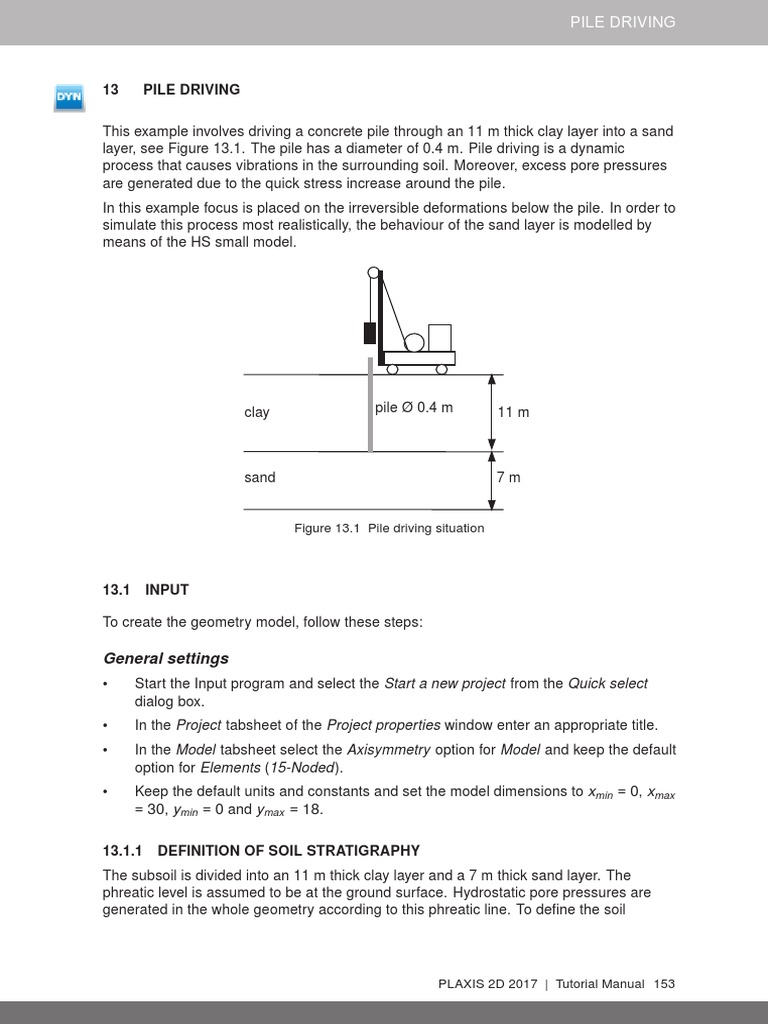In the realm of geotechnical engineering, the application of finite element analysis (FEA) software like PLAXIS has revolutionized the way professionals approach complex ground and foundation engineering problems. One topic that frequently arises is the feasibility of employing a two-dimensional (2D) analytical framework while utilizing a three-dimensional (3D) modeling environment, specifically within the context of PLAXIS 3D. This inquiry merits attention, as it opens a dialogue about dimensionality in modeling and its implications for accuracy, resource allocation, and problem-solving intricacies.
The essence of the inquiry into working in 2D using PLAXIS 3D lies in an understanding of dimensional paradigms. 2D modeling offers a simplified approach that can be appealing due to its relatively lower computational demand and faster execution times. This efficiency can be particularly attractive when dealing with preliminary design phases or vast projects where a full three-dimensional model might be considered excessive. However, the transition to a 3D environment raises pertinent questions concerning the fidelity and applicability of such simplified models under varying conditions.
One primary advantage of employing 2D models lies in their relative ease of interpretation. In scenarios such as analyzing simple structures or assessing soil behavior in homogeneous ground conditions, a 2D representation can suffice. It allows engineers to visualize stress distributions and displacement profiles effectively without the added complexity of three-dimensional interactions. Nevertheless, the significance of the third dimension cannot be underestimated, especially in projects where spatial variability and non-linear behavior are prevalent. In such instances, 3D modeling provides indispensable insights that a two-dimensional model might inadequately capture.
From a technical standpoint, 2D modeling in PLAXIS 3D is indeed possible, albeit with certain compromises. This capability is inherently linked to the software’s flexibility, which allows users to establish a cross-sectional model that can effectively represent specific scenarios. For example, where subsurface conditions can be approximated in a uniform manner, leveraging 2D capabilities in a 3D environment could streamline the process. On the other hand, while engineers may opt for a 2D analysis, it is critical to consider the underlying assumptions that govern such simplifications, as they may not encompass the complexities of actual geotechnical behavior.
The diverse applications of PLAXIS 3D necessitate a deeper understanding of how dimensions influence modeling outcomes. A frequent observation is that critical phenomena such as soil arching, wall interaction, and ground settlement involve intricate three-dimensional effects. Simplifying these behaviors into 2D may facilitate ease of analysis, but could lead to significant inaccuracies. With non-linear material behaviors and geometrical configurations, the nuances of 3D modeling become essential to replicate field conditions accurately.
Furthermore, utilizing PLAXIS 3D for 2D analyses presents intriguing challenges. One such challenge revolves around the boundary conditions imposed in a 2D framework versus a 3D one. In a 2D setting, the assumption of infinite extensibility can lead to oversimplified results without addressing the threshold constraints often observed in practice. Hence, ensuring that boundary conditions are adequately represented becomes pivotal. In contrast, 3D analyses permit a more holistic view, offering insights into how the interaction between structures and the surrounding environment can dramatically alter performance predictions.
As geotechnical projects grow in complexity, the trend leans toward 3D modeling capabilities reflecting the real-world multifaceted nature of geotechnical systems. However, the proclivity of some practitioners to rely on 2D models brings to light another critical aspect: the balance between computational efficiency and solution fidelity. While quicker results can be enticing, the long-term repercussions of neglecting three-dimensional considerations may culminate in unforeseen complications, subsequently resulting in augmented costs and project delays.
Nevertheless, there are scenarios wherein working in 2D may serve as a prudent starting point before delving into more intricate 3D models. Engineers often employ such preliminary assessments to identify possible issues or areas of concern. This iterative approach can be beneficial, allowing for the strategic allocation of resources and focused investigations on problem areas that warrant further scrutiny. The iterative design processes, typical in PLAXIS, enable a structured progression from simpler models to more sophisticated analyses, quasi-empowering engineers to construct a more comprehensive understanding of their projects.
Another aspect that merits exploration is the ongoing advancements in computational technology. As computational power escalates, the argument favoring 3D analyses gains compelling traction. Enhanced algorithms and processing capabilities facilitate the execution of extensive simulations, allowing engineers to delve into the complexities of geotechnical problems with increased precision. This revolution raises the question of whether maintaining a hybrid approach where both 2D and 3D analyses coexist might truly serve as the optimal methodology in balancing computational efficiency and accuracy.
In conclusion, while it is indeed feasible to work in 2D using PLAXIS 3D, the decision to do so warrants careful consideration. The intricacies of geotechnical interactions necessitate a holistic understanding of the impact of dimensional constraints on analysis outcome. The allure of simplicity and speed should be measured against the potential for critical oversight inherent in reduced-dimensional modeling. Ultimately, the choice to employ a 2D model may serve specific purposes and foster initial insights, yet engineers must persistently engage with the implications of their modeling choices, continually striving for accuracy and reliability in their analyses.












